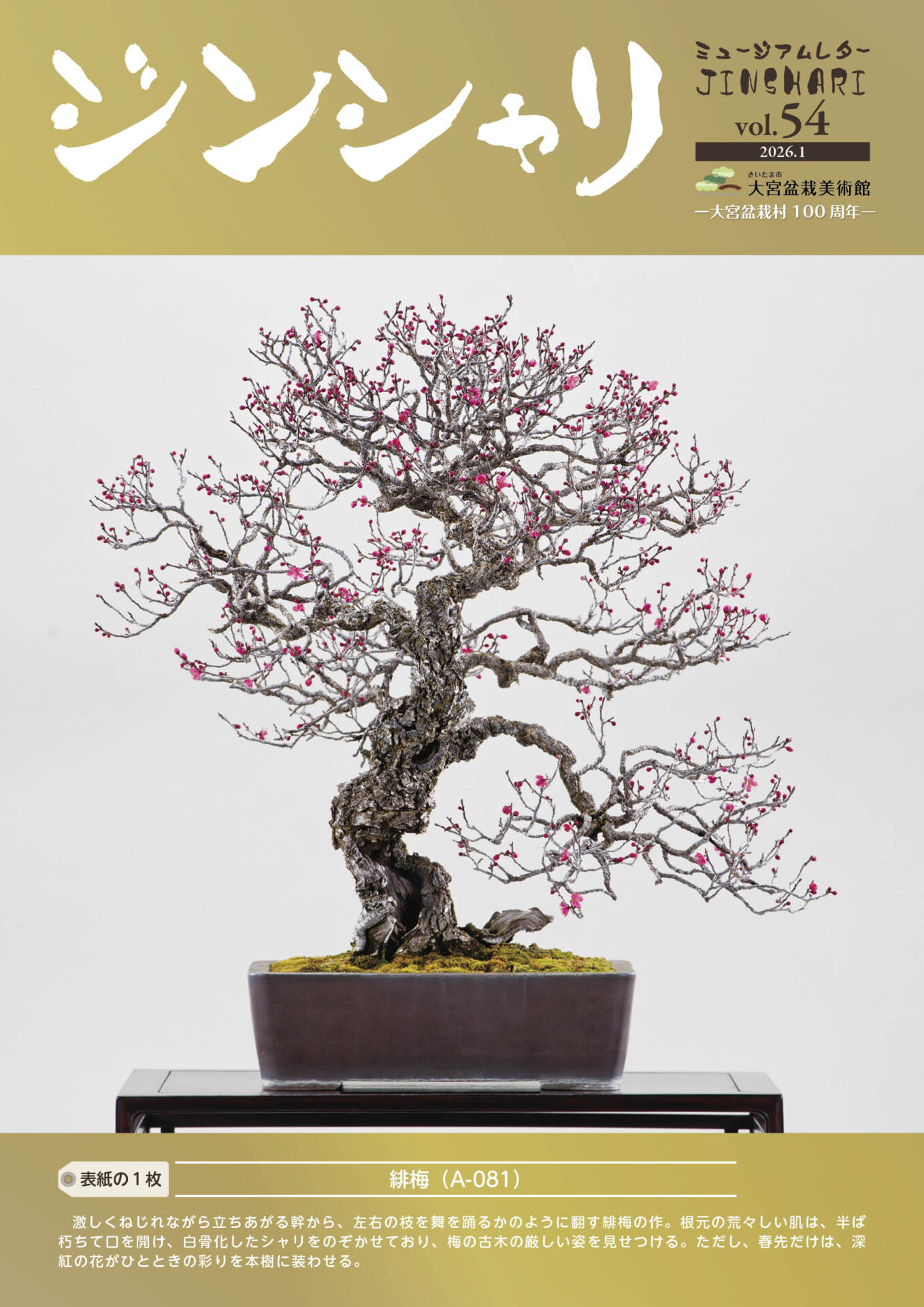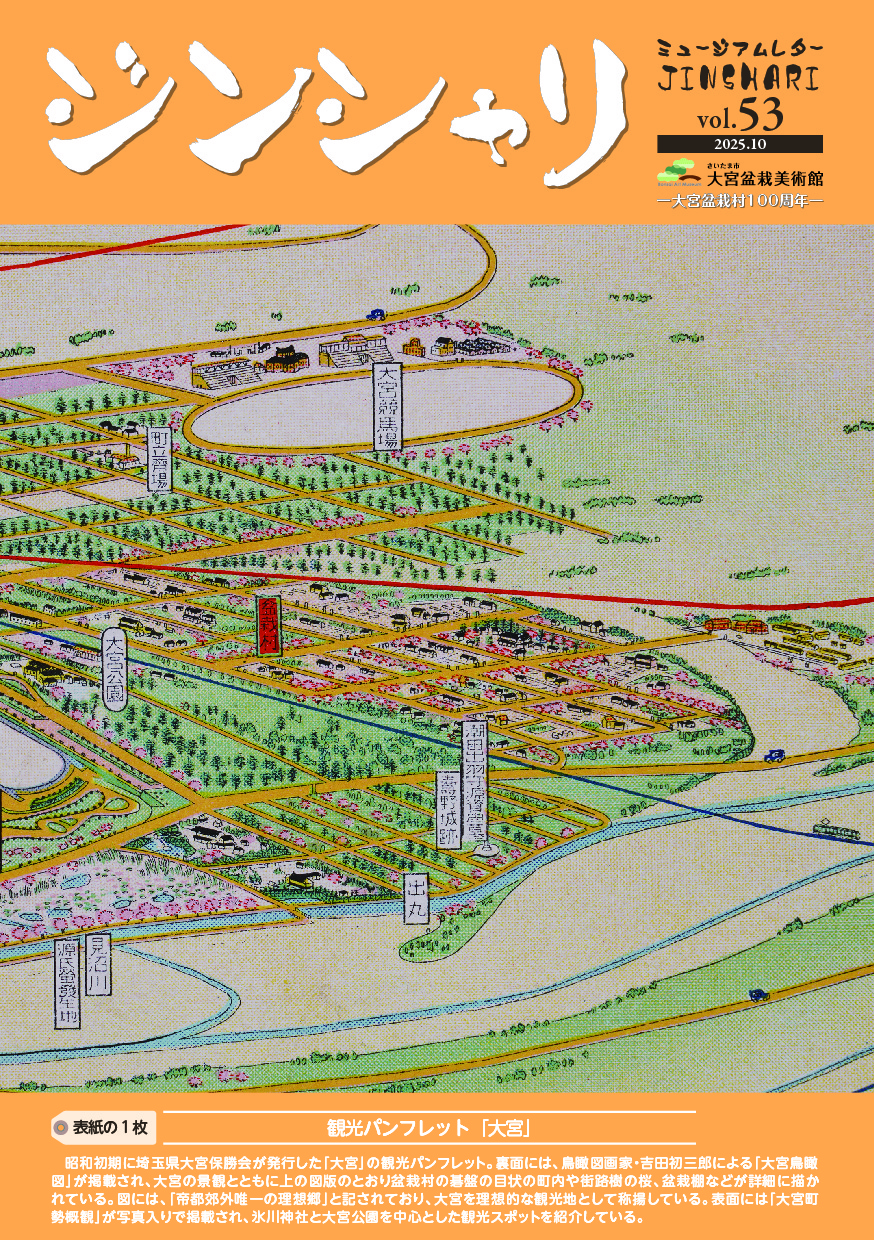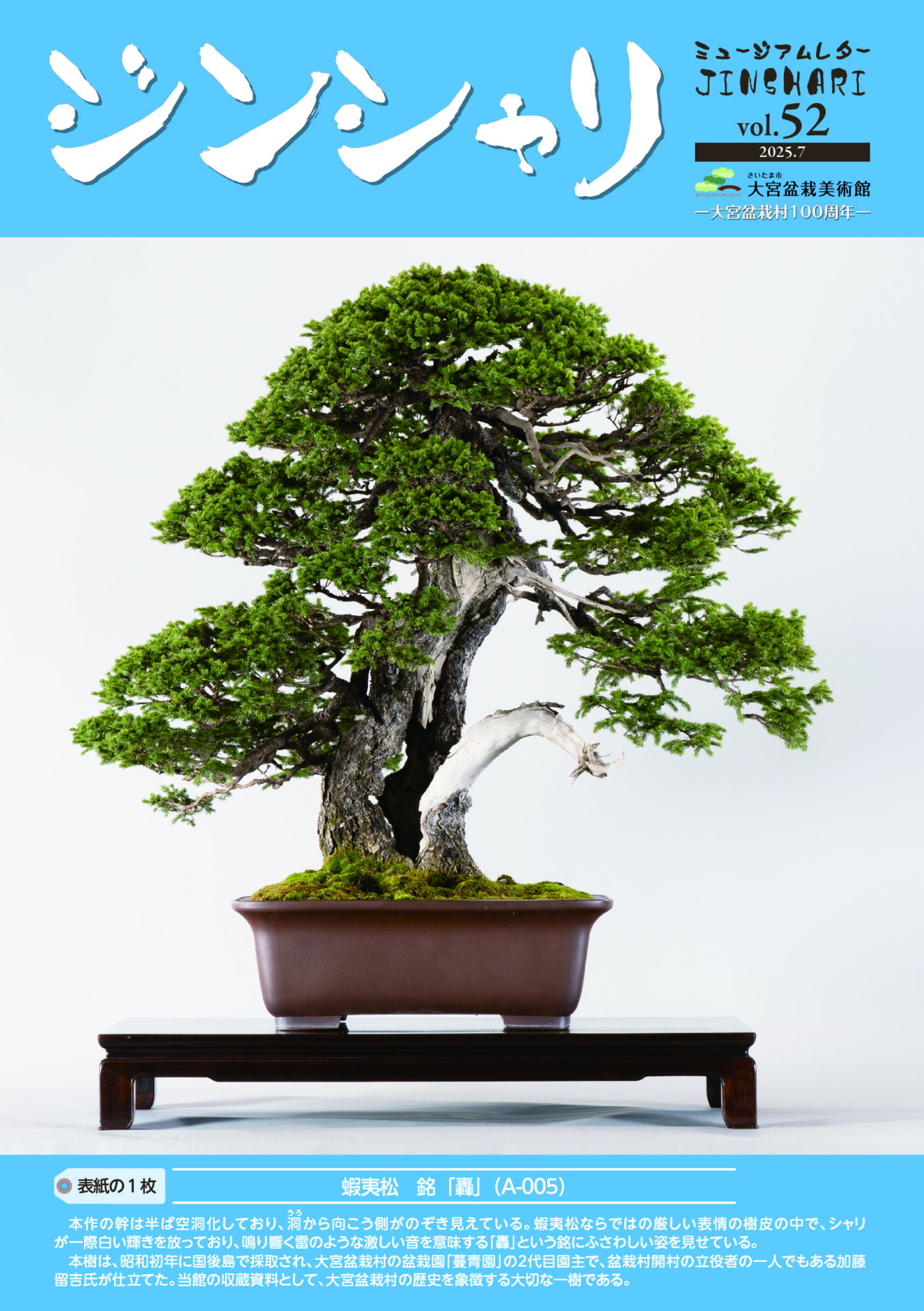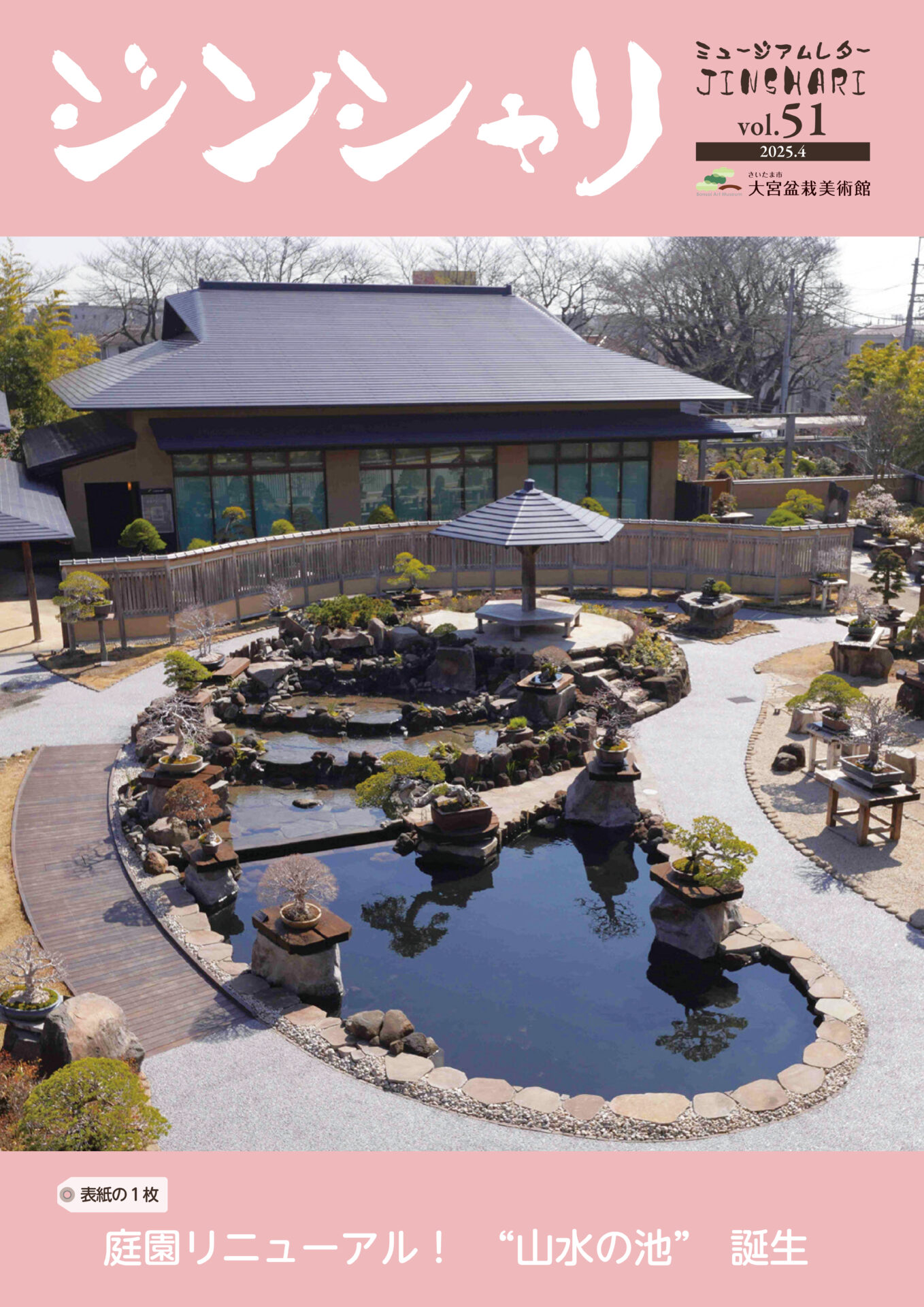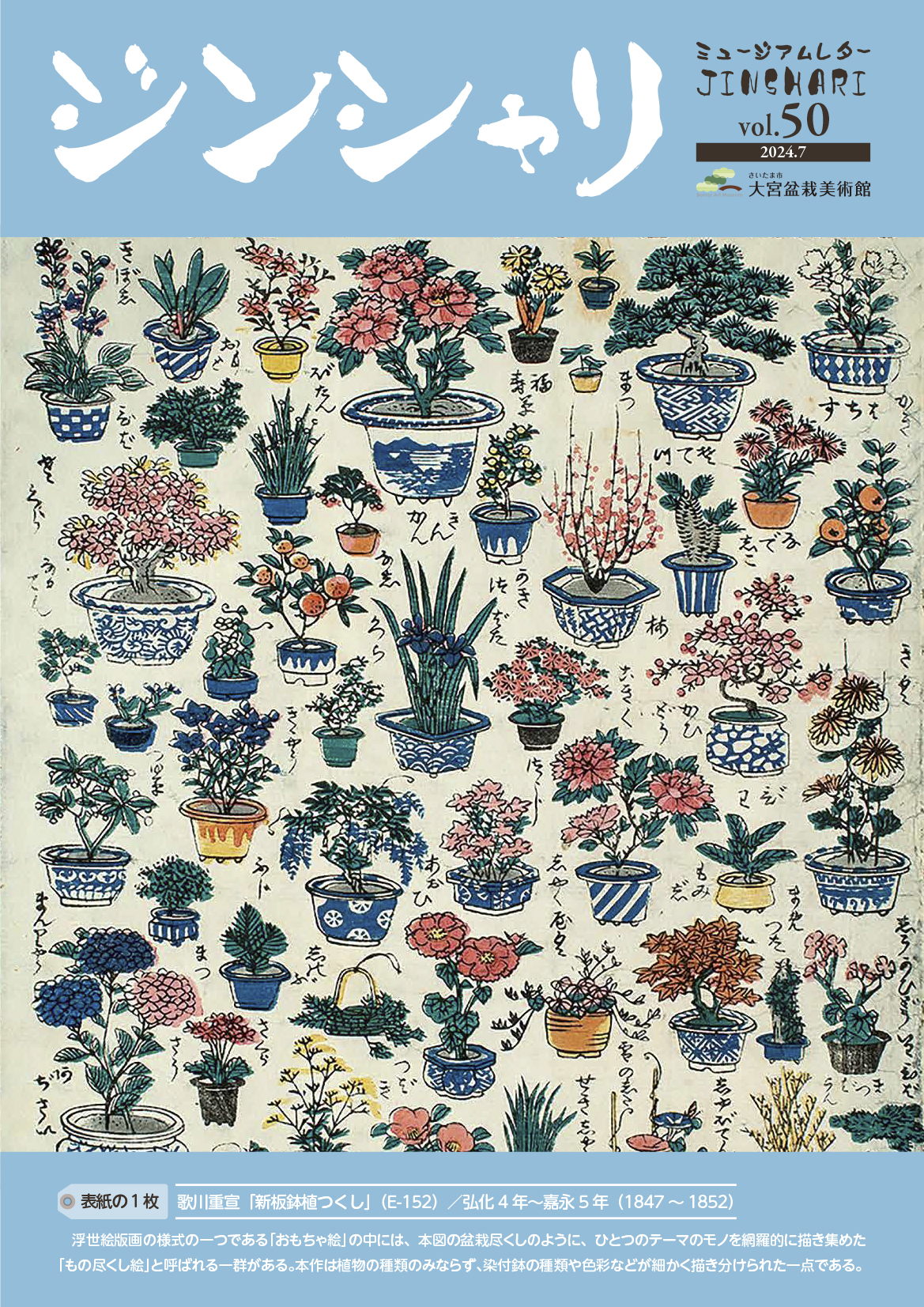Jinshari Vol.49
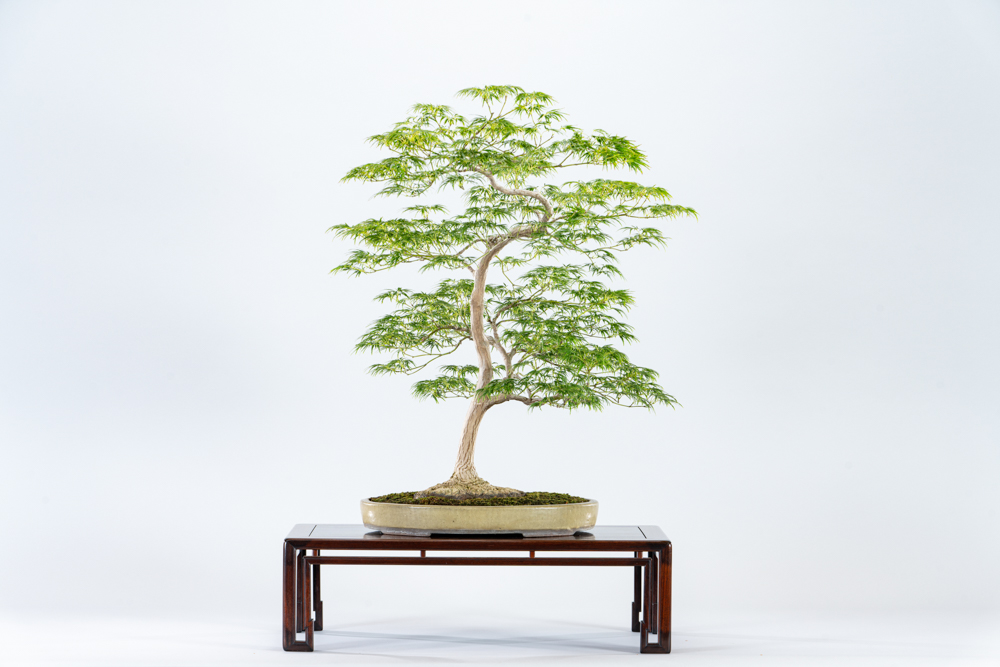
-
【Front Picture】Aoshidare Japanese Maple
This is a bonsai of an “aoishidare”, a variety of Japanese maple. Its thin branches extend out and droop down. The deep notches in its leaves are a highlight.
One can feel the breeze of an early summer from its bright, lush leaves against the white bark one can uniquely see on maple trees.
Behind the Exhibits
“Shoku” - The Best Supporting Role in Zashiki Room Decoration
Bonsai shine in the alcoves inside of zashiki (traditional Japanese tatami rooms). In zashiki-kazari (the art of decorating a zashiki room), bonsai will take center stage as they are combined with other items such as pots, tables, companion pieces, and hanging scrolls to create a harmonious room. Out of these decorative items, shoku, which are wooden decorative stands, work to help bonsai stand out the most. A more refined feeling may be garnered from a bonsai on a shoku than from one outside. Our Behind the Exhibits corner for this issue will put a spotlight on shoku, showing how they act as an amazing supporting role a bonsai, letting them shine.
There are numerous shapes and designs of shoku and one will choose a shoku to fit with the size, style, and shape of the bonsai one wishes to display. For example, one would use a ki-joko, a desk shoku, for a bulky formal upright or curved trunk bonsai. For a cascade-style bonsai, you would use a taka-joku (tall table), which have long legs. For grass bonsai low tables called small hira-joku and maki-joku are also used. Shoku are often created using imported woods such as Chinese quince and rosewood, shoku made with bamboo are often used in the summer as they give off a cool feeling.
At the Omiya Bonsai Art Museum, we change our indoor displays in the Collection Gallery once a week, so we require a large number of shoku. The Omiya Bonsai Art Museum already has 80 in our collection, but in the last fiscal year, Mr. Kyoji Matsuda who runs a bonsai garden in Kanagawa Prefecture, donated 12 more shoku from Mr. Kyoji Matsuda. Each of these shoku was made by craftsmen who worked during the Meiji to Showa era, such as Yuzan Ogawa, Kozan Katsuragi, and Kazuhiko Kaneko, and each shoku is an extremely valuable piece of art. It is rare for shoku like these which were made by modern craftsmen to come out on the market, so are objects of envy in the bonsai world.
With these donations, we believe that we will be able to more fully bring out the shape of our masterpiece bonsai trees when we display them. Please look forward to when they will be shown to the public.
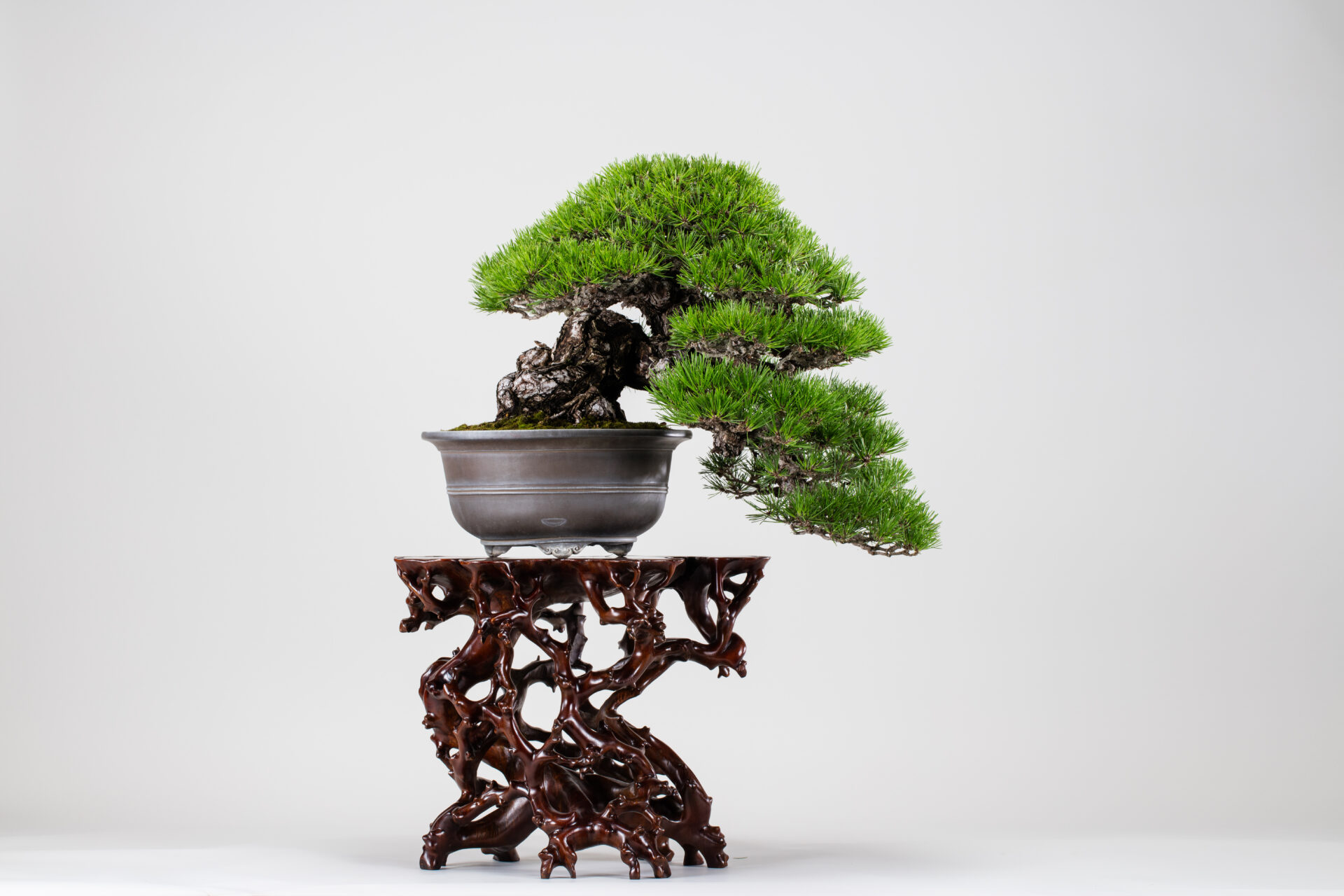
Bonsai: Japanese Black Pine (A-069) / Shoku: Natural Tall Table (Taka-joku)/ This tall table was sculpted to appear like complex intertwining tree rots. A great harmony can be felt between this and the lively semi-cascade style of this pine tree.
Artist’s Work
Pinching – Maintaining a Bonsai’s Beautiful Form
In spring the warmth of the sun beams down on us. When fresh leaves start to bud in this season, it is time for bonsai artists to begin a very important spring job, bud pinching. New Buds and shoots will grow quickly in the spring. This can cause issues for bonsai which are supposed to be kept small. As such, bonsai artists suppress the growth of trees using a number of pruning techniques.
One of these techniques is bud pinching. This is the process of using tweezers to take off the end bud of a branch when it begins to swell, leaving the two leaves between it (stopping the point of growth). If you miss this timing, the branch will grow out, resulting in the loss of a compact feel to the branches. The trick to pruning is said to lie in creating an overall balance by having parts that are left to grow and others that are cut short.
The technique of bud pinching was researched and established by the first-generation owner of Fuyo-en Bonsai Garden in the Omiya Bonsai Village, Fusazo Takeyama. He is famous as a master of deciduous bonsai. He developed the technique through experimentation, testing where and when to pinch the bonsai through experimentation. Prior to this, the growth of the tree was suppressed by first waiting for a branch to fully grow, cutting it down to its base, and then letting a new bud grow. However, this method resulted in clumps at the tips of branches branch tips, so according to Fuyo-en Bonsai Garden, Mr Fusazo began research into how to create delicate twigs,
Eventually, this bud pinching technique spread amongst other bonsai artists and enthusiasts due to the well-formed shape of the branches of bonsai that had been pinched. It was also explained in bonsai handbooks and has now become a common technique used on a variety of tree species. Cultivation techniques have been developed through the efforts of our predecessors. Even today, new cultivation methods are still being tried and tested, leading to even better techniques being developed frequently.
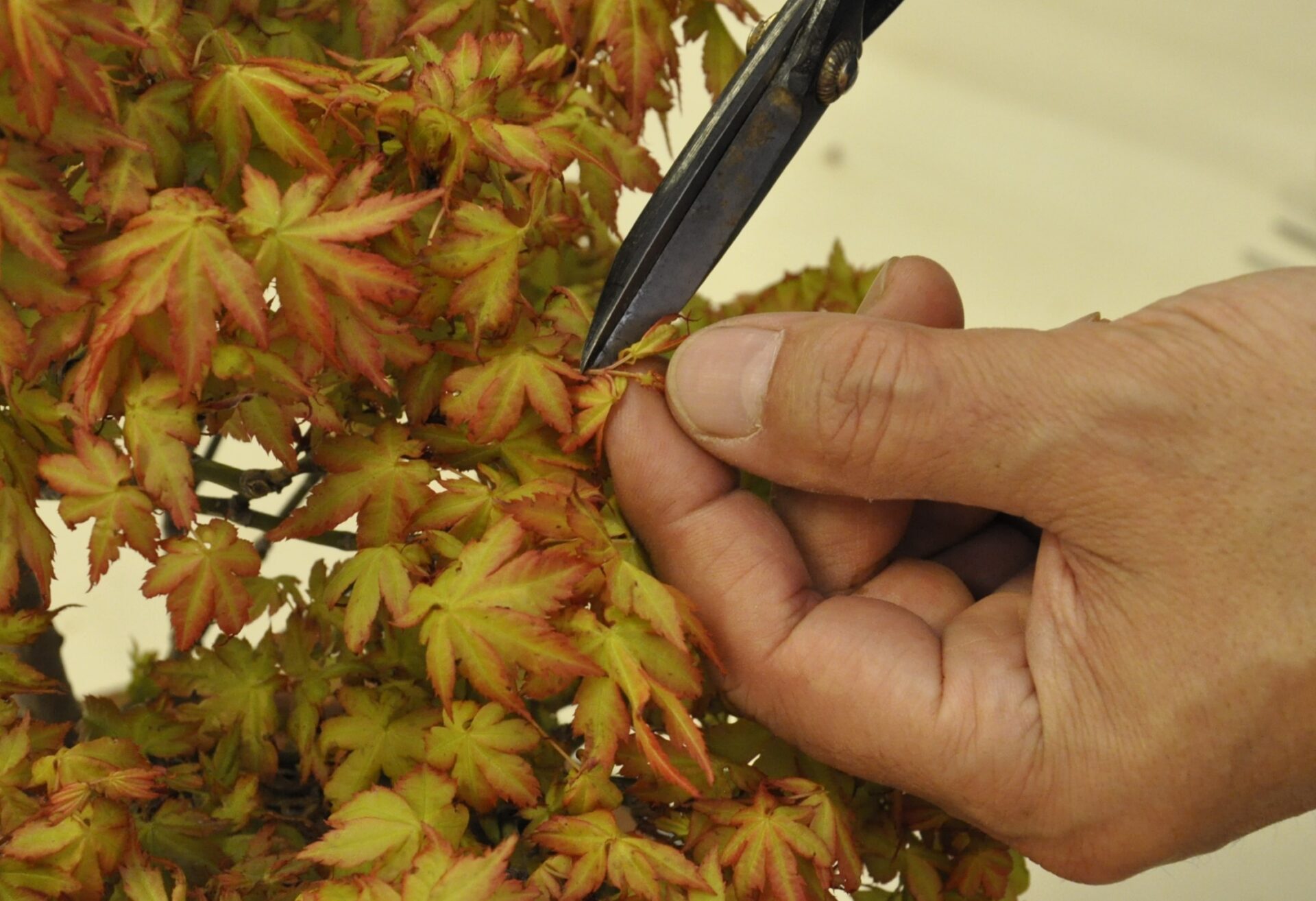
Pinching buds on a Japanese maple
Supporter Reporter
'Supporting Children's First Trip to an Art Museum' - School Trip Support .
【Numerous events at the Omiya Bonsai Art Museum are held together with the Museum Supporters, a group formed of \ volunteers. In this issue, one of the Museum Supporters will tell us all about guides, one of the 5 activities that the Supporters take part in. 】
When the primary school children saw historic and famous bonsai in the museum, or when they saw small chrysanthemums or gentian flowers that just started to open up, they exclaimed in an excited or quiet voice "This bonsai is my favorite".
I was initially worried that third-graders might not find bonsai interesting, but they were so gripped by the bonsai that the security guard at the museum said, "The brims of their hats looks like they're going to hit the bonsai"!
I imagined that the bonsai were a bit shy at being surrounded and having their pictures taken, especially with the very popular Todoroki Ezo spruce, which is 1000 years old, and the Japanese juniper Hokusai. They were enthralled by the bright red leaves of the ivy bonsai in autumn and the fuchsias that browned under the winter sky. The children didn’t miss any of the bonsais that seem to be standing there casually, but in fact, have been selected and are well cared for.
They agreed with each other, saying "I like that one too!" on the way home, and were sad that they had to leave their favorite bonsai behind. I know that you are all sad, but Kagayaki, the Japanese white pine is still the same as ever. The Asian spicebush is changing dramatically, however.
I hope I can continue to have a good time with the children who come to visit the museum. It might be their first time at an art museum, so I want help them in a casual way, so they think I am just being friendly.
Museum Supporter - Nozomi Kozabayashi
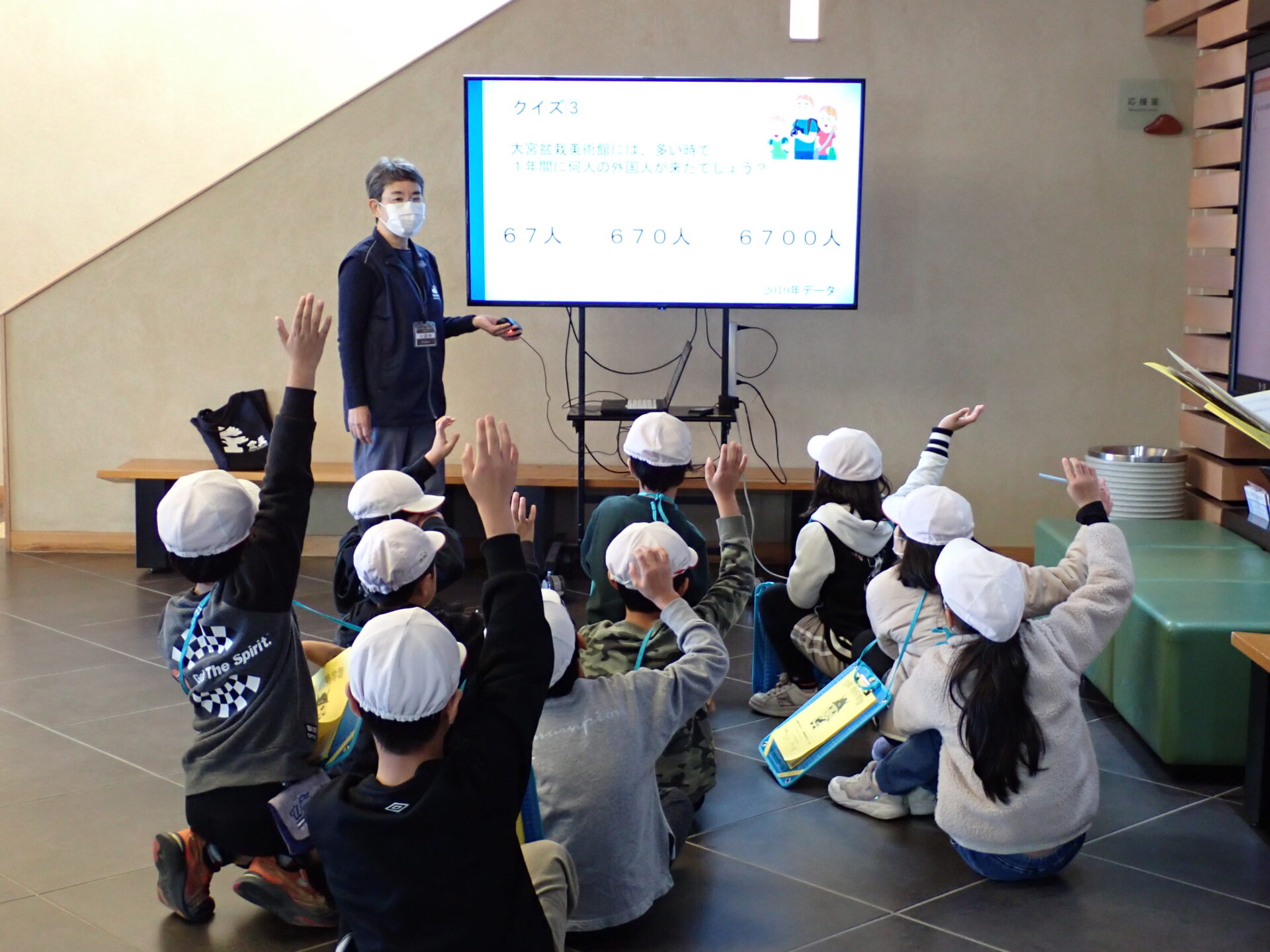
We Aid Learning through Quizes
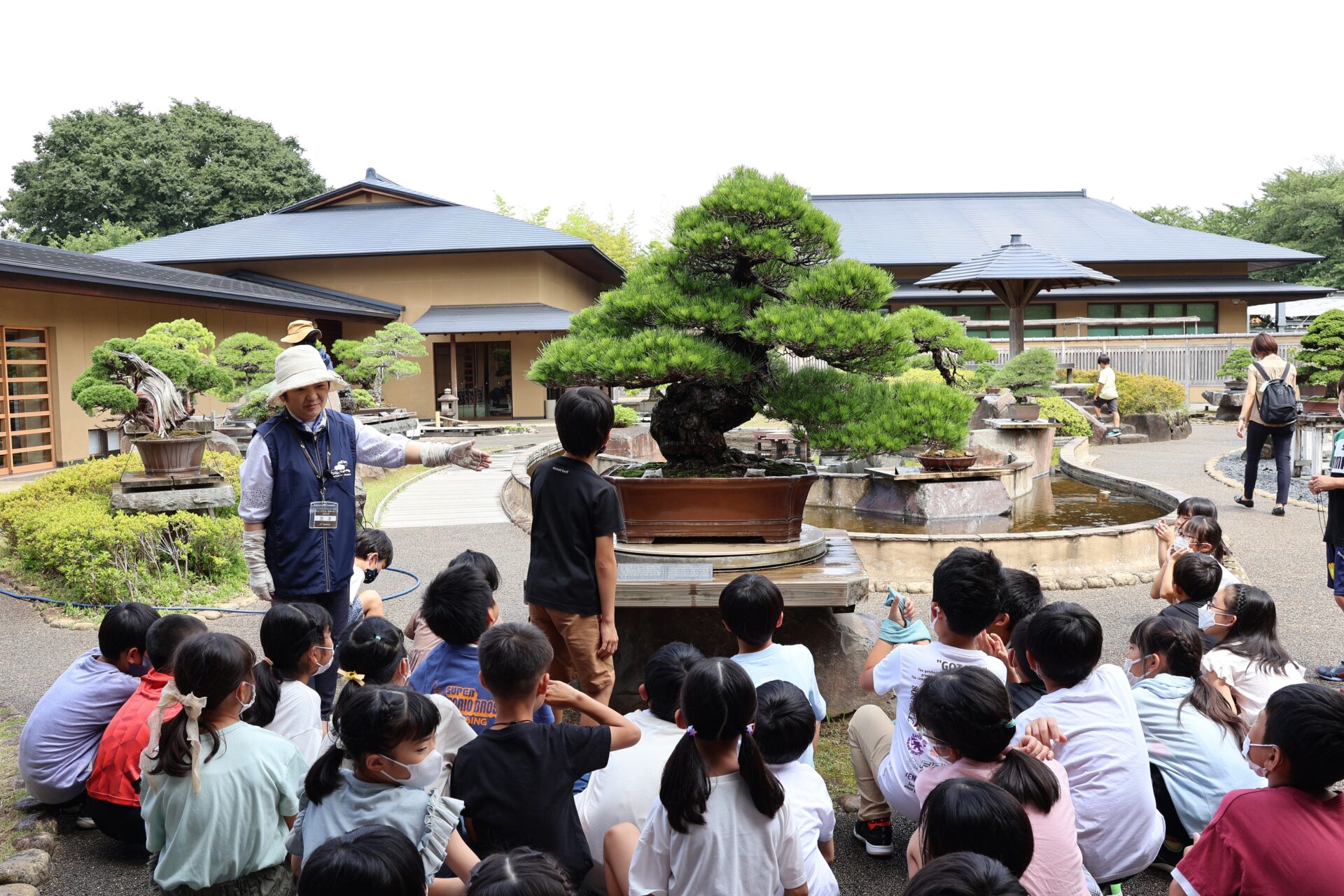
Sometimes We are Surprised by Their Reactions





